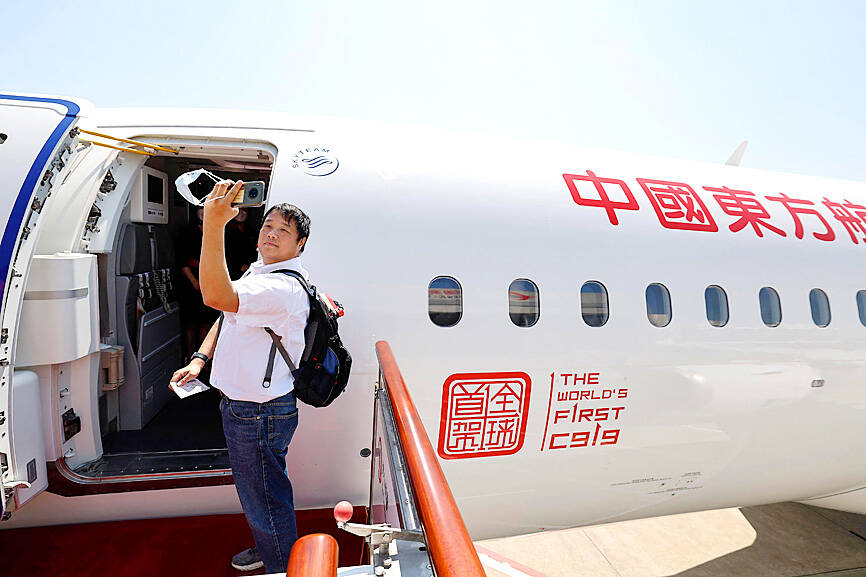China’s first domestically produced passenger jet made its maiden commercial flight yesterday, a milestone event in the nation’s decades-long effort to compete with Western rivals in the air.
Beijing hopes that the C919 commercial jetliner would challenge foreign models such as the Boeing Co 737 MAX and the Airbus SE A320, but many of its parts are sourced from abroad.
Its first homegrown jetliner with mass commercial potential would also cut the country’s reliance on foreign technology as ties with the West deteriorate.

Photo: AFP
“In the future, most passengers will be able to choose to travel by large, domestically produced aircraft,” China’s state broadcaster China Central Television (CCTV) said.
China Eastern Airlines Corp (中國東方航空) Flight MU9191 from Shanghai “arrived smoothly” in Beijing just after 12:30pm, about 40 minutes ahead of schedule, CCTV said.
China has invested heavily in production of the homegrown jet as it seeks to become self-sufficient in key technologies.
The aircraft is manufactured by state-owned Commercial Aircraft Corp of China (COMAC, 中國商用飛機), but many of its parts — including its engines — are sourced from overseas.
The flight was a “coming of age ceremony [for] the new aircraft,” COMAC marketing and sales director Zhang Xiaoguang (張小光) told China’s official Xinhua state news agency, adding that the C919 “will get better if it stands the test of the market.”
From today, the C919 would operate on China Eastern’s regular route between Shanghai and the southwestern city of Chengdu, CCTV reported.
The first model of the narrow-body jet was formally handed over to China Eastern last year.
The company had taken about 1,200 orders for the C919, COMAC deputy general manager Zhang Yujin (張玉金) told state-backed Shanghai daily The Paper in January.
COMAC plans to increase annual production capacity to 150 models within five years, Zhang said at the time.
Asia, and China in particular, are key targets for European manufacturer Airbus and its US rival Boeing, which are looking to capitalize on growing demand for air travel from the country’s vast middle class.
Last month, Airbus said that it would double its production capacity in China, signing a deal to build a second final assembly line for the A320 in China’s northern city of Tianjin.
The first assembly site opened in 2008 and produces four A320s per month, with Airbus hoping to increase that to six per month before the end of the year.

With an approval rating of just two percent, Peruvian President Dina Boluarte might be the world’s most unpopular leader, according to pollsters. Protests greeted her rise to power 29 months ago, and have marked her entire term — joined by assorted scandals, investigations, controversies and a surge in gang violence. The 63-year-old is the target of a dozen probes, including for her alleged failure to declare gifts of luxury jewels and watches, a scandal inevitably dubbed “Rolexgate.” She is also under the microscope for a two-week undeclared absence for nose surgery — which she insists was medical, not cosmetic — and is

CAUTIOUS RECOVERY: While the manufacturing sector returned to growth amid the US-China trade truce, firms remain wary as uncertainty clouds the outlook, the CIER said The local manufacturing sector returned to expansion last month, as the official purchasing managers’ index (PMI) rose 2.1 points to 51.0, driven by a temporary easing in US-China trade tensions, the Chung-Hua Institution for Economic Research (CIER, 中華經濟研究院) said yesterday. The PMI gauges the health of the manufacturing industry, with readings above 50 indicating expansion and those below 50 signaling contraction. “Firms are not as pessimistic as they were in April, but they remain far from optimistic,” CIER president Lien Hsien-ming (連賢明) said at a news conference. The full impact of US tariff decisions is unlikely to become clear until later this month

GROWING CONCERN: Some senior Trump administration officials opposed the UAE expansion over fears that another TSMC project could jeopardize its US investment Taiwan Semiconductor Manufacturing Co (TSMC, 台積電) is evaluating building an advanced production facility in the United Arab Emirates (UAE) and has discussed the possibility with officials in US President Donald Trump’s administration, people familiar with the matter said, in a potentially major bet on the Middle East that would only come to fruition with Washington’s approval. The company has had multiple meetings in the past few months with US Special Envoy to the Middle East Steve Witkoff and officials from MGX, an influential investment vehicle overseen by the UAE president’s brother, the people said. The conversations are a continuation of talks that

CHIP DUTIES: TSMC said it voiced its concerns to Washington about tariffs, telling the US commerce department that it wants ‘fair treatment’ to protect its competitiveness Taiwan Semiconductor Manufacturing Co (TSMC, 台積電) yesterday reiterated robust business prospects for this year as strong artificial intelligence (AI) chip demand from Nvidia Corp and other customers would absorb the impacts of US tariffs. “The impact of tariffs would be indirect, as the custom tax is the importers’ responsibility, not the exporters,” TSMC chairman and chief executive officer C.C. Wei (魏哲家) said at the chipmaker’s annual shareholders’ meeting in Hsinchu City. TSMC’s business could be affected if people become reluctant to buy electronics due to inflated prices, Wei said. In addition, the chipmaker has voiced its concern to the US Department of Commerce